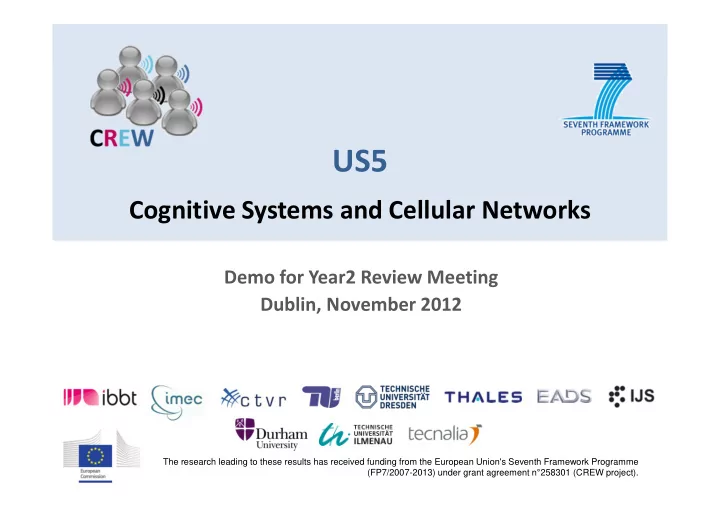

US5 Cognitive Systems and Cellular Networks Demo for Year2 Review Meeting Dublin, November 2012 The research leading to these results has received funding from the European Union's Seventh Framework Programme (FP7/2007-2013) under grant agreement n ° 258301 (CREW project).
Demo Setup Primary system Secondary system (5 MHz LTE signal) (Random 5 MHz signal) The power of the secondary system is increased to TCS Multi-antenna Cognitive device determine the detection limit (LTE sensing agent) with 1 and 4 antennas 1
Context of US5.1 Motivation US5.1: Impact of cognitive networking on a cellular incumbent system The opportunistic system must not interfere in any way with the incumbent system Find a spectrum band that is available Periodically verify that the band is still available Proposed solution Parallel sensing approach based on antenna processing Use of TCS multi-antenna LTE sensing platform 2
Context of US5.1 3
Serial sensing vs. parallel sensing Serial sensing Parallel sensing Advantages Advantages Classically high SIR No need to adjust the waveform High sensing sensitivity Higher system capacity Basic sensing algorithms can be used Drawbacks Drawbacks Need to adjust the waveform to sensing Current SIR is always low Insertion of quiet periods Need to use more robust sensing algorithm Reduced capacity of the system � � � � Reference based detection using antenna processing 4
Demo Goals We will demonstrate that a LTE signal (primary) can be detected even in presence of a strong secondary signal Use of a multi-antenna LTE sensing test-bed Use of reference based detection algorithm for LTE We will prove that multi-antenna approach validate parallel sensing Gain in SIR of around 30 dB Over-the-air demo 5
Functionality to be demonstrated Functionality to be demonstrated Interference rejection capabilities of the TCS multi-antenna LTE cognitive system Validation of the parallel sensing approach 6
Recommend
More recommend